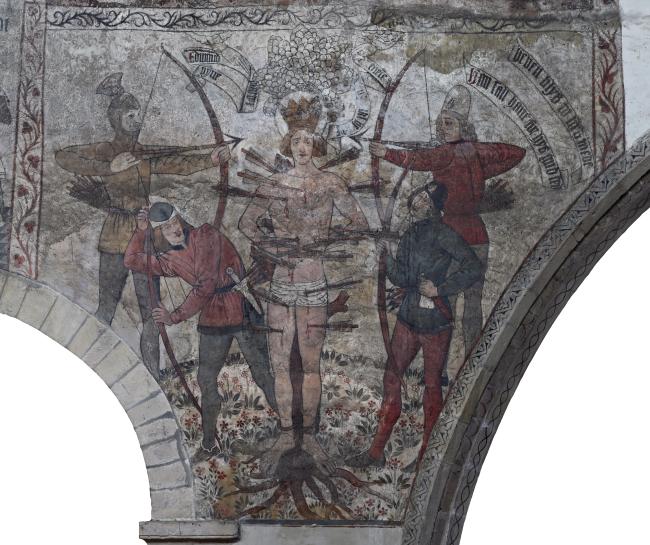Nigel Walter, Trustee and Chair of our Grants Committee, reviews Kate Giles’s new book about the wall paintings of the church of St Peter & St Paul, Pickering in North Yorkshire.
Kate Giles’s new book tells the compelling story of the remarkable wall paintings in the parish church of the market town of Pickering, North Yorkshire. The story told is both unique to this particular building, and at the same time also of far broader interest and application, making for a hugely enjoyable and rewarding read.
The book tells of the discovery, in 1852, of a fragmentary wall painting during repair works to the roof of the church. Further plaster was removed to reveal an exceptionally complete fifteenth-century scheme covering the north and south sides of the nave, from above the arcade all the way to the top of the clerestory. The discovery provoked regional and national interest, as well as considerable local pride.
But others strongly disapproved, most notably the conservative vicar, who disliked having his church suddenly thronged with Catholic saints and martyrs. Accordingly, he sought permission from the Archbishop of York to have the paintings destroyed, feeling them to be ‘out of place in a Protestant church, especially in these dangerous days’. Thankfully, the archbishop did not allow their removal, and instead they were painted over.
Controversial repainting
Then in 1880 a new, ecclesiologically-minded curate arrived, seeking to restore both congregation and building. The paintings were uncovered once again, but their condition was found to be poor and the decision was taken to ‘restore’ them, leading to their controversial repainting. Pevsner, in his Buildings of England volume, describes this restoration as ‘ruthless’, but consoles us with the view that 'as they had never been great art, it is perhaps better to see them now clearly than to see their original brushwork dimly’.
Kate Giles tells the story of the paintings in this beautifully produced book. To do this, she looks beyond the question of their quality as works of art, adopting instead an archaeological approach. As she says, archaeology refuses to 'judge between periods: it takes each layer of the story on its own terms in the belief that the complex interactions between people and paintings seen in Pickering speak of a more vibrant, conflicted and active engagement’.
As a result of this method, the status of these paintings is enhanced, and each twist in this convoluted tale yields lessons of interest. One particular focus is the sense in which the community valued these images, almost as if adopting them as family. By going beyond the art historical, what emerges in vivid colour is the way in which the building was argued over. Those arguments concern belief in the broadest sense – not only doctrinal belief, but also the values that constitute a community – the very definition of a tradition and a community in good order.
Responsible conservation
As a result, alongside the meticulous account of the history of the church and its paintings, we also learn by extension the story of the community in that place through time. There is a sense of each nourishing the other – the building needing the ongoing commitment of its community in order to survive, while the identity of the people of the parish as a community is constituted by the building. And concern for that nexus – the binding together of people and place – both lies at the heart of responsible conservation and is central to the remit and work of the National Churches Trust.

Having recounted the contested history of these paintings in the modern era, Giles then explores the relationship between this imagery and the devotional practices of the later middle ages. She suggests how these paintings would have combined with preaching, drama, music and prayer to create a profoundly immersive, sensory experience.
These paintings shouldn’t therefore be seen as mere scenery, but rather as something with agency, bringing to focus the communion of saints – the church community extended from the past through the present and to generations still to come. The paintings thus helped create a space that is 'rich and meaningful, layered with the memories and presence of the dead and imbued with the prayers of the faithful for the future’.
The book is lavishly illustrated, with high-quality photos of the paintings as they are now, conveying well the power of the images. Historical depth is added with reproductions of the various earlier stages of survey drawings.
But perhaps the book’s greatest contribution is the way it weaves the multiple strands discussed above into a single story. As Giles herself suggests, her book is a story about the relationship between people, place and meaning – and as such that story provides lessons applicable to almost any church. One can hope that a book of this quality will encourage many more such stories to be told – one church, chapel or meeting house at a time.
Publication details: Katherine Giles. The Wall Paintings of Pickering Church: Their Discovery, Restoration and Meaning. Donington: Shaun Tyas, 2022, viii + 200 pp (hardback £20) ISBN: 978-1-915774-01-9.
How to buy your copy: The book will be sent post-free within the UK by the publisher, who can be contacted on 01775 821542, or by email at shaun@shauntyas.myzen.co.uk or by writing to 1 High Street, Donington, Lincolnshire, PE11 4TA.

